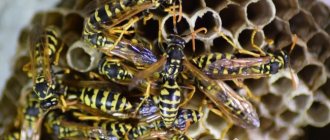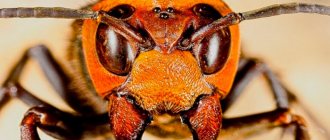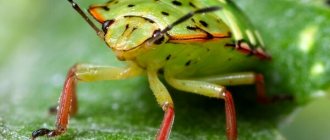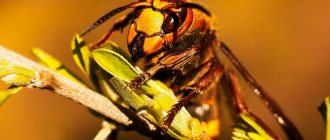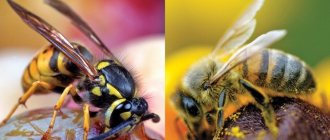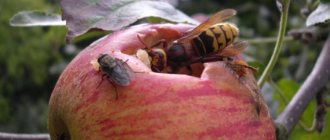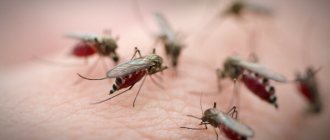Lifestyle of hornet and wasp. Appearance of insects - size, body anatomy, sting. Danger of poison to humans. Construction of a wasp and hornet nest. Symptoms that accompany the bite. Health care. Allergy to the bite.
Hymenoptera are a large order of insects that include many species and genera. People often confuse them with each other, so you need to figure out how a hornet and a wasp differ, understand their appearance, danger, lifestyle and reproduction. Knowing the details, you can protect yourself from stinging hymenoptera.
Main differences
Entomologists have devoted many years to studying these types of insects, so now you can easily understand the differences between wasps, hornets, and bumblebees. The first, and most important, difference is the size. The hornet is the largest when compared with all social wasps - a subfamily group that uses paper during construction.
But size is not the only difference. It is also worth mentioning the difference in pigmentation. An ordinary wasp is characterized by a classic yellow color, while a hornet is darker, most often brown. There are also differences in the caliber of the tip. Despite the fact that hornets are not the largest representatives of Hymenoptera, they do not use their stings as often as wasps, since they are less aggressive in nature.
Differences between a hornet and a wasp
The largest representative of the wasp family is the hornet. The length of its body can reach 5 centimeters. In addition to the size of the body, differences also apply to the structure of the body. Hornets have a large head, a fairly wide and large chest, which is darker in color, and the abdomen is also larger.
There are differences in the construction of nests, namely in the building material:
- Wasps. They use tree fibers to build their houses. They moisten them in their saliva and chew them, obtaining a pliable building material. From the outside, such a house resembles crumpled paper; such a house has numerous layers, with honeycombs placed in the lower part.
- Hornets. They use rotted stumps and wood as building materials. Their nests are dark brown in color.
Regarding the territories where they live, they can be found in all regions of the country except the northern ones. In some regions, hornets are considered an endangered species. Regarding wasps, they are considered useless stinging insects, which is completely unfair.
Hornets inflict very painful stings, during which they release paralytic poison, which is highly concentrated. If a person suffers from allergic reactions, a bite can cause anaphylactic shock and even be fatal.
Wasps are distant relatives of wasps and ants. They differ in that they do not care for their offspring at all, they lay eggs in cells, after which they seal them and never return to them.
They have a sting about 5 mm long. They attack people only for protection when they feel danger. They attack with powerful jaws and then use a sting. At one time they can bite and sting several times. They feed on nectar, pollen, fruit and tree sap, and their diet also includes caterpillars and spiders.
Lifestyle
The hornet and the wasp are social insect species. Socialized Hymenoptera increases the population through the laying of eggs by the queen, which can reproduce more than two thousand workers in one fertilization. They are busy building nests. The activity of members of the family depends on the time of year.
When it comes to what differentiates wasps from bees, they do not produce honey, and their feeding method differs depending on the species.
Wasp diet:
- In the summer, they consume flower nectar, bee honey, fruit juice, vegetables, and berries. Sweets and rotten foods are also considered delicacies;
- They are greedy for kvass, lemonades, fruit and vegetable juices, jams, syrups;
- Often, predators attack a bee family, destroying the hives in just 2 hours. They consume the honey themselves, and take the bees to feed the larvae.
Hornets hunt smaller representatives of insects - wasps, flies, caterpillars.
Differences between insects
These representatives are quite similar to each other, but at the same time they have many differences. They all have the ability to fly, they buzz, and each of them can sting painfully, in addition to which they secrete toxic poison. But they never attack just like that, only when they feel a threat to themselves or their family, this is how they defend themselves.
If you look at bees, it is worth noting their hard work; they are busy working all day long. In addition to collecting honey all day, they also build honeycombs, clean the hive, feed the young generation, provide ventilation to the hive, process and store the collected product.
The life cycle of a working individual is on average 1 month, but the younger generation grows up quickly and families are regularly replenished, so such a short life remains unnoticed by others.
Differences in appearance, photos
In appearance, the insects are quite similar, but differ in size. The queen hornet reaches a length of about 4-5 centimeters, the working individual and the male are slightly shorter. Common wasps are on average comparable to other Hymenoptera species. The working individual reaches 1.2–1.4 centimeters in length, the female – 1.8 centimeters.
In addition, it is necessary to say about the differences in color and other features. Small wasps do not have a shade of brown on their bodies - their colors are predominantly yellow and black. Large relatives are characterized by the presence of a brown tint, most often in the cephalothorax area.
The two representatives are distinguished by their characteristic thin waist, powerful jaws and large visual organs, but there are differences in the size and shape of the head. The hornet has an almost round shape and a wide nape, the wasp is small in size and has a narrowed shape near the base.
Description
Let's tell you about what a hornet looks like. The body of the dipteran insect reaches 1.8-2.4 cm, and the body of the uterus reaches 3.5 cm. The female and male hornets look almost identical, and visible differences can only be detected with magnification: thus, males have 13 antennal segments, females - 12, on the abdomen of males there are 7 segments, and in females - 6.
Males, unlike females, do not have a stinging process. The eyes have an orange tint and are curved like the letter “c”. The body of the insect is covered with numerous hairs.
Nest construction
The presented insects construct similar hives. The main difference is the color. The wasp family builds gray cocoons, while the hornet family builds brownish ones. Rotten wood and birch bark are used as construction materials.
The housing structure of the Hymenoptera is characterized by its multi-tier structure and oval shape. The population size is affected by the size of the hive. Regarding the location of the nest, it is impossible to distinguish wasps from hornets, since one prefers the same locations - old cavities in tree trunks, bird nests, the roof and attic of a human house.
Features of life
When comparing how a hornet differs from a wasp, it is necessary first of all to analyze the behavior of these insects. Wasps, depending on their species, can be solitary or social. In the latter, the head of the entire family is a large, fertile uterus. It is she who spends the winter in a secluded place and, with the onset of the first warm days, wakes up from sleep, finds a suitable place where she builds honeycombs, laying eggs in them. Soon, the first working individuals emerge from such eggs and actively begin expanding the nest.
In just two or three months—already in June—the wasp population increases, division into castes occurs, with certain groups of insects engaged in construction, others protecting the nest, and others looking for food and feeding the larvae. With the onset of the first cold weather, all workers and males die, the nest becomes empty, and fertilized females fly away to spend the winter in secluded places. This cycle is repeated from year to year, allowing the population of these insects to be maintained.
Hornet feeds:
- wasps;
- various insects;
- sweet molasses.
Solitary wasps also build nests, but they are much smaller in size than those of social species. Often this can be a secluded hole in the ground or a small crevice in a tree. Such a nest primarily serves to protect the insect from the cold and enemies. Fertilized females can lay offspring, and they either leave insects they have killed next to the eggs as food or even use various caterpillars as donors, inside whose bodies larvae subsequently appear, eating away the insides of their prey.
From the point of view of zoologists and in their behavior, hornets belong to social wasps. In a large colony, all power belongs to the fertilized queen, and responsibilities in such a family are clearly distributed. Some individuals look after the queen and her larvae , others protect the family from enemies, others are exclusively engaged in building the nest, and working individuals look for food.
The difference between hornets and most social wasps is the fact that they do not collect pollen or make honey. These are pronounced predators that hunt other insects, feed on them, and feed their larvae with chewed pulp.
Hornets are active predators; they hunt other insects, do not disdain even their relatives, and especially love to feast on honey bees. A dozen of these large insects can completely destroy an entire bee colony in just half an hour. Therefore, the invasion of hornets will become a big problem for beekeepers, and it will be simply impossible to ward off such predators in any way.
Vespiary
Wasps independently obtain building material. It is an old stump, a tree, a fence, various buildings made of wood - this affects the gray tint of the hive. When a suitable material is found, the insect begins to moisten it with its own saliva, after which it scrapes off the thin wood fibers. Powerful jaws are used to collect a sufficient amount of building material.
Having made preliminary preparations, the stingers go to the place where the construction of the cocoon is planned. Next, the lumps are once again processed using the jaws and generously moistened with sticky secretion. Afterwards, the process of forming the cells of the hive begins - strips of material are rolled out perpendicularly, as a result - the formation of a thin paper cell wall, over time a complete housing is obtained.
Where do hornets and wasps spend the winter?
With the arrival of cold weather, wasps go for the winter; for this they need to find a secluded place. Most often they overwinter under the bark of a tree, in the cracks of outbuildings, hollows, and old stumps. Until this time, they must accumulate a large amount of nutrients, which will be gradually consumed throughout the winter. They leave the nest they build over the summer and never return to it.
In hornets, this process is almost identical, but there are differences. Over the summer, they build a nest and make nutritious food reserves, raising the young generation. With the arrival of autumn, the females leave the nest to mate and then find a secluded place for the winter. At that time, the workers begin to close all exits from the nest; throughout the winter they will remain inside and feed on the reserves they have made.
If severe frosts strike, unfortunately, the working individuals will die, but the queen will remain, and with the arrival of warmth, she will lay eggs and create a new swarm. Wintering involves deep and long sleep, which continues until early spring.
Females that left the colony in the fall, after hibernation, look for a new place to build a nest and create a separate colony. These amazing insects are listed in the Red Book as they are considered an endangered species.
Hornet's nest
Hornet also has excellent construction skills. They form their nest using rotten wood, which is first chewed and moistened with saliva. The resulting building material is used to create honeycombs and the frame of the hive; saliva is used as glue. The dried frame is similar in appearance to corrugated paper. The shade is usually brown, but can vary as different types of wood are used.
This large stinger will never use its nest next year. After wintering, the queen looks for a comfortable place to start building a new home. A “leg” is attached to the base, to which the first honeycomb cells are attached.
Cocoons grow from top to bottom. The number of tiers gradually increases, as well as the formation of a multilayer shell. Depending on the number of layers laid, one can guess the size of the population living in this hive. The design is characterized by a shell of up to 8 centimeters, thanks to which the larvae are protected from summer heat, sudden temperature changes and strong winds.
Distinctive features of the nest
Wasps and hornets build very similar nests. They will differ mainly in color. For the former it is gray, and for the latter it is brownish. For construction, the latter insects use rotten wood and birch bark, so they produce a brownish building material.
The housing structures of Hymenoptera are multi-tiered and have the shape of an oval, pear, or ball. The population size depends on the size of the house. It is impossible to distinguish a wasp from a hornet by the location of its nests, since they similarly build their homes in old cavities in tree trunks, bird nests, under the roof of human houses or in their attics.
wasp nest
Wasps and their especially large relatives have to independently obtain material for construction. For these purposes, wasps use old stumps, trees, fences, and various wooden buildings, so the color of their house is always predominantly gray.
Having found a suitable material, the insect settles on it , moistens it with its saliva and begins to scrape off thin wood fibers, performing backward movements. Powerful jaws help her collect a sufficient amount of material.
After preliminary preparation, the insect goes to where it plans to build a nest. The wasp once again processes the lump of material with its jaws and thoroughly moistens it with a sticky secretion.
From the prepared building material, the insect performs manipulations to form nest cells. To do this, she rolls out several strips of material in a perpendicular direction. As a result, a thin paper wall of the next cell is formed, and after a while a complete dwelling.
Hornet's nest
Hornets are also known for their good construction skills. They form their nests from rotten wood. Insects chew it and moisten it with saliva. From the resulting material they make honeycombs and a nest frame, using their saliva instead of glue. The dried frame resembles corrugated paper. The color is most often brownish, but the shade differs depending on the type of wood.
These large insects never use their nests the following year. After overwintering, the queen hornet looks for a convenient place to build a new home. She attaches a small leg to the ceiling, on which the first cells of the honeycomb are fixed.
A hornet's nest grows from top to bottom. The number of tiers gradually increases and a multilayer shell is formed. The more layers of honeycombs are laid, the larger the population living in this house will be. The shell of the structure up to 8 cm protects the larvae from summer heat, temperature changes and drafts.
Human interaction
Many people have encountered wasp bites - this is a rather aggressive insect that attacks almost immediately if they sense a dangerous situation. The hornet is less aggressive towards people, but will attack if there is danger for itself, family or nest.
Lesser Hymenoptera often flies into human possession because they are attracted to food supplies. They easily enter residential buildings and apartments through an open window, but will bite if threatened.
Attacks by a whole swarm are very dangerous for people. A wasp can sting up to three times in a minute, sticking its sting under the skin of a person, they inject poison. If a large amount of a toxic substance enters the bloodstream at the same time, the human body can react unpredictably, the consequences will be especially severe for allergy sufferers.
If we talk about hornet behavior, it is influenced by taste preferences. They prefer sweet foods - honey, sugar, fruits, berries. But relative to humans, they are not so aggressive. An attack is carried out only if there is a presentiment of real danger. To feed the larvae, they catch insects, caterpillars, and spiders.
Comparing the bites of two stinging ones, the second ones sting not so painfully, but there is still a risk of an allergic reaction with difficult consequences. The victim experiences swelling, hyperemia of the bitten skin, pain, and a local increase in temperature. Allergy sufferers experience nausea, vomiting, general loss of energy and breathing problems.
Danger to humans
Wasps and hornets are predominantly peace-loving insects that, if undisturbed, will simply not pay attention to humans. However, at the first sign of danger they begin to attack the enemy. Wasps have a sweet tooth, attracted by the smell of sugar, nectar, berries, and especially honey. Therefore, such insects often fly into human homes, where they sting people.
The sting of a wasp, and especially a hornet, is extremely painful for humans. Swelling, a red spot, discomfort, and a local increase in temperature appear on the skin. Adult hornets, especially in the second half of summer, usually accumulate a large amount of poison, which when bitten is extremely painful, and if there is an allergy, it can almost immediately cause anaphylactic shock and death in a person.
Hornets are especially dangerous if their colony and nest are disturbed. In such a case, this insect will violently attack the enemy, and almost the entire huge swarm attacks. In most cases, such an attack by these large, fast and dangerous insects ended in death for humans. Therefore, under no circumstances should you try to destroy a hornet nest in a private house or on a summer cottage on your own. In such a case, you need to contact specialists who will solve the existing problems using appropriate chemicals.
The difference between a hornet and a wasp is the structure of its sting. Wasps, like bees, have special notches on their sting that prevent them from being retrieved after an attack. Therefore, the insect stings only once in its life, after which it immediately dies due to the entrails torn off along with the sting. But the hornet’s sting is perfectly smooth , so the insect can immediately take it out and use it again for its intended purpose, injecting a new portion of poison.
It has been established that hornets are able to mobilize in just a few seconds and attack a person or any enemy in order to protect their colony. Sensing danger, this insect releases a special substance - alarm pheromones, which are immediately activated to attack other hornets. Therefore, it is not recommended to kill such huge wasps near their nest, as this may immediately provoke an attack by the entire family on the offender. It has also been established that substances emitted by dead hornets or their prey and various food seasonings, including apple and banana flavors, can provoke an attack.
What to do if bitten by a stinging insect
Many people do not know what to do if they are bitten by a member of the wasp family. When severe pain occurs, you can understand that the body is undergoing destruction. It is necessary to understand that the poison contains toxins that have a strong effect on the nerve endings, which is why the pain shock is very pronounced.
In normal situations, it is difficult to imagine the consequences of an attack because everyone reacts differently. Some may get by with only pain and swelling, while others may face dire consequences, including asphyxia, loss of consciousness, and even death.
It is very important not to hesitate and immediately provide first aid:
- Remember the main rule - there will be no sting in the wound, only poison, so there is no need to look for it and try to squeeze it out.
- Try to remove the toxic substance by sucking it out.
- Treat the affected area of the skin with citric or acetic acid.
- Try washing the wound with soapy water.
- Treat the wound with a solution that contains alcohol; you can also use hydrogen peroxide.
- Apply something cold and wet sugar to the wound - this will reduce the rate at which toxins spread through the blood.
- Do not drink alcohol if you are bitten - this will increase swelling and worsen the general condition of the victim. Attacks to the neck and head area are especially dangerous.
- If you take into account folk remedies, you can use dandelion juice, plantain juice, and soda solution. A slice of onion and garlic works great.
Symptoms of an allergic reaction are accompanied by:
- Severe headache;
- Increased body temperature;
- Rapid heartbeat;
- Heavy breathing;
- Abdominal pain.
If the above induced symptoms occur, the victim should take a pain reliever tablet to reduce the effects of histamine. You should also drink plenty of water to reduce poisoning.
Remember that if there is no improvement in your condition, consult a doctor immediately.
Our pest control services!
We offer you focal initial and final disinsection, as well as preventive disinsection. Initial disinfestation involves the destruction of insects at the initial stage of their appearance. Thanks to its use, it is possible to prevent infection with various diseases, as well as the appearance of adult larvae.
We carry out the elimination of insects and rodents at objects of any purpose!
Final disinfestation is carried out when complete destruction of all insects and prevention of their reappearance is required. We talked about preventive disinfestation above. We offer to use our services not only in apartments and country houses, but also in warehouses, industrial premises, offices, restaurants, cafes, country houses and gardens.
Remember that your health and well-being are in your hands!
Trust such a delicate problem exclusively to professionals. We will always be happy to help you get rid of insects forever. At any time that is convenient for you, we will come and clean up the premises. We are always ready to help you on weekends and weekdays.
Our company is the best assistant for deratization and disinfestation in the South-East Administrative District and other districts of the capital. Complete confidentiality is guaranteed. Our SES service operates throughout the region and even beyond!
